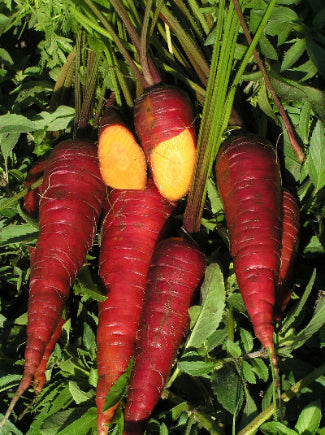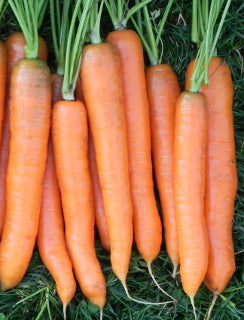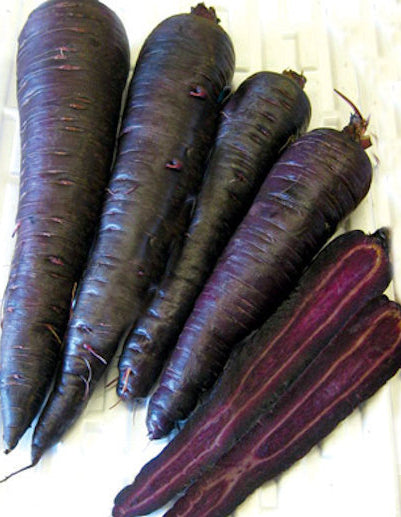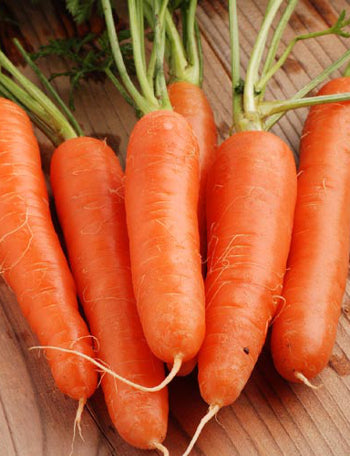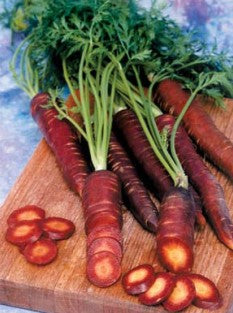How to Grow Carrots
The essential guide to growing carrot (Daucus carota subsp. sativus) from seed; with notes on germination, cultivation, harvest and even kitchen uses.

Seeds per gram: 600 – 900
Feed requirement: Low (sow after a previously fertilised crop)
Know your carrot types & kitchen uses:
- Nantes – cylindrical, blunt-ended roots, very sweet, little core; perfect raw sticks, juicing and quick roasting.
- Imperator – long, tapered supermarket shape with crisp texture; great for shredding into salads or glazing whole.
- Danvers – classic conical roots that tolerate heavier soils; balanced flavour suits soups, stews and winter storage.
- Chantenay – short, broad shoulders tapering quickly; excels in shallow or rocky soil and is superb for roasting or baby-cut snacks.
- Mini and coloured heirlooms – rainbow hues or stumpy “Paris Market” balls; add visual punch to crudités and pickles. Also good for shallow or rocky soil.
Germination:
- Optimal soil temperature 10 – 24 °C; seed takes 10 – 21 days to emerge.
- Work a shallow furrow 6 – 12 mm deep and 20 – 30 cm apart.
- Mix seed 1 : 3 with fine, dry compost or sand for even distribution; sprinkle thinly.
- Keep the surface constantly moist—lay hessian, shade cloth or planks over the row in hot weather, removing at first sign of green.
Cultivation:
- Loosen soil to 25–30 cm; remove stones and clods to prevent forking.
- Avoid fresh manure or high‑nitrogen fertiliser; excess N causes leafy tops and misshapen roots.
- Where clay lies close to the surface, choose short or stump‑rooted varieties.
- Maintain steady moisture; large wet–dry swings lead to cracking and poor flavour.
- Thin seedlings to 3 cm apart for baby carrots or 5–8 cm for full‑size roots.
- Sow every four weeks from early spring to late summer for continuous harvests.
- For in‑ground winter storage, sow a winter‑holding variety between late January and mid‑February.
- Hill a little soil over orange crowns in winter beds to protect from rodents and sunlight.
Problems & Pests:
- Forked or hairy roots: caused by stones, clods, or excessive nitrogen.
- Patchy germination: surface dried out; ensure constant moisture.
- Rodent damage in winter: mound soil over crowns or fit mesh guards.
- Carrot rust fly (where present): cover beds with insect mesh and rotate crops.
Harvest:
- Begin pulling when roots reach usable size; flavour is best when tops just start to lift.
- Harvest winter‑stored rows before flower‑stalks form to avoid woody cores.
- Use roots fresh, roasted, or juiced; tender carrot tops make a tasty parsley substitute—especially in carrot & orange soup.
Sowing Periods
| J | F | M | A | M | J | J | A | S | O | N | D | |
|---|---|---|---|---|---|---|---|---|---|---|---|---|
| Cool | ||||||||||||
| Temperate | ||||||||||||
| Sub-Tropical/Tropical |
Filters
11 products
Carrot 'Amsterdam Forcing'
Sale priceFrom $3.75
CARROT 'French Round'
Sale price$3.75
CARROT 'Manchester Table'
Sale price$3.75
Carrot 'Purple Dragon'
Sale priceFrom $3.75
CARROT 'Yellow Lobbericher'
Sale priceFrom $3.75
Carrot ‘All Seasons’
Sale priceFrom $3.75
Carrot ‘Deep Purple’ F1
Sale price$3.75
CARROT ‘Early Nantes’
Sale priceFrom $3.75
CARROT ‘Purple Dayz’ F1
Sale price$3.75
Carrot ‘Rainbow Mix’
Sale price$3.75
CARROT ‘Scarlet Nantes’
Sale price$3.75




